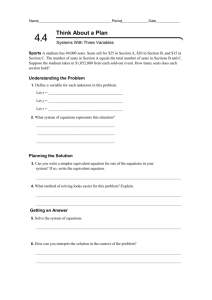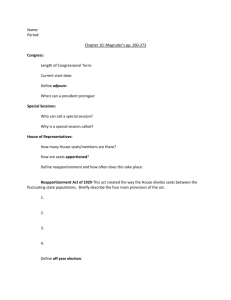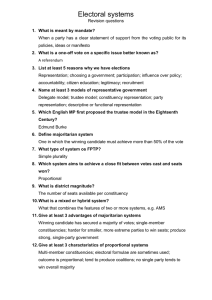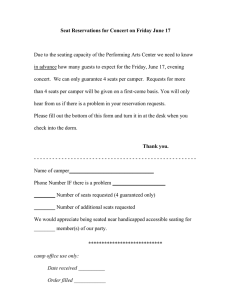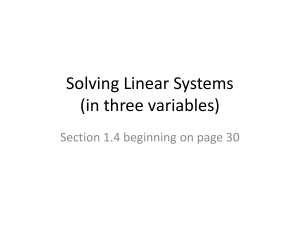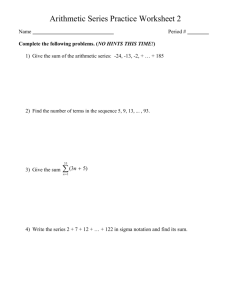OXFORD CAMBRIDGE AND RSA EXAMINATIONS Advanced Subsidiary General Certificate of Education
advertisement
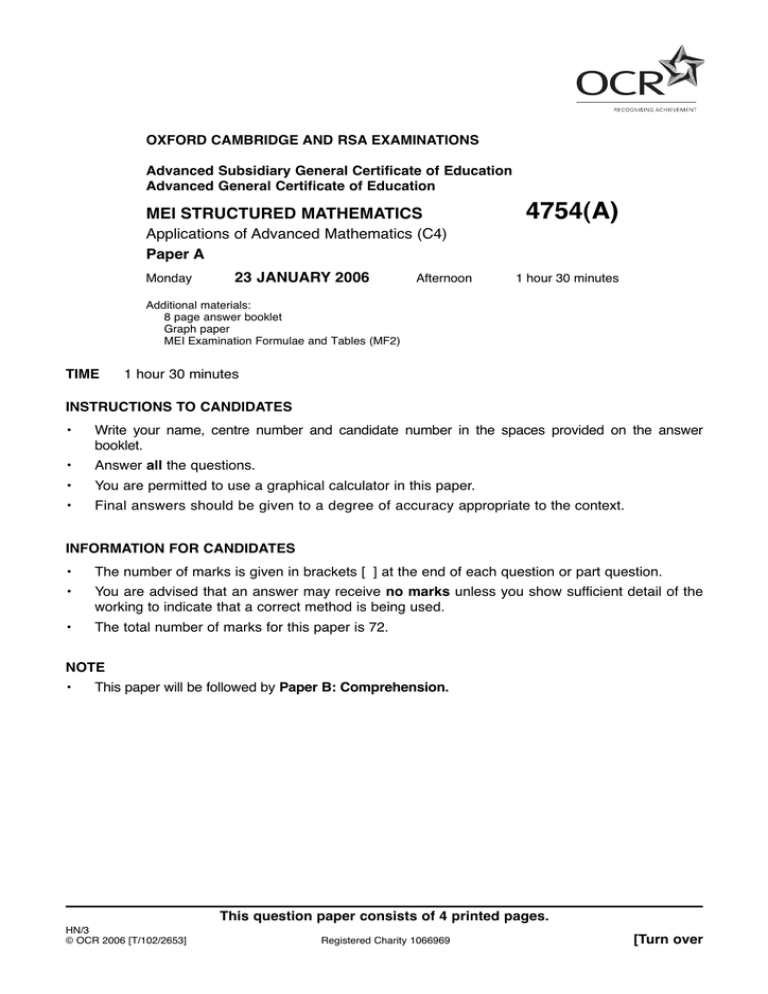
OXFORD CAMBRIDGE AND RSA EXAMINATIONS Advanced Subsidiary General Certificate of Education Advanced General Certificate of Education MEI STRUCTURED MATHEMATICS 4754(A) Applications of Advanced Mathematics (C4) Paper A Monday 23 JANUARY 2006 Afternoon 1 hour 30 minutes Additional materials: 8 page answer booklet Graph paper MEI Examination Formulae and Tables (MF2) TIME 1 hour 30 minutes INSTRUCTIONS TO CANDIDATES • Write your name, centre number and candidate number in the spaces provided on the answer booklet. • Answer all the questions. • You are permitted to use a graphical calculator in this paper. • Final answers should be given to a degree of accuracy appropriate to the context. INFORMATION FOR CANDIDATES • The number of marks is given in brackets [ ] at the end of each question or part question. • You are advised that an answer may receive no marks unless you show sufficient detail of the working to indicate that a correct method is being used. • The total number of marks for this paper is 72. NOTE • This paper will be followed by Paper B: Comprehension. This question paper consists of 4 printed pages. HN/3 © OCR 2006 [T/102/2653] Registered Charity 1066969 [Turn over 2 Section A (36 marks) 2x 4x 3. x 2 x1 1 Solve the equation [5] 2 A curve is defined parametrically by the equations x t ln t, y t ln t (t 0) . Find the gradient of the curve at the point where t 2. [5] 3 A triangle ABC has vertices A (2, 4, 1 ) , B ( 2, 3, 4 ) and C ( 4, 8, 3 ) . By calculating a suitable scalar product, show that angle ABC is a right angle. Hence calculate the area of the triangle. [6] 4 Solve the equation 2 sin 2q cos 2q 1, for 0° q 360°. 5 [6] (i) Find the cartesian equation of the plane through the point ( 2, 1, 4 ) with normal vector Ê 1ˆ n = Á -1˜ . Á ˜ Ë 2¯ [3] (ii) Find the coordinates of the point of intersection of this plane and the straight line with equation Ê 7ˆ Ê 1ˆ r = Á12˜ + l Á 3˜ . Á ˜ Á ˜ Ë 9¯ Ë 2¯ 6 [4] (i) Find the first three non-zero terms of the binomial expansion of 1 for x 2. [4] 4 - x2 1 1 Û dx , rounding your answer to (ii) Use this result to find an approximation for Ù ı0 4 - x 2 4 significant figures. [2] 1 Û dx = arcsin (iii) Given that Ù ı 4 - x2 4 significant figures. ( ) 1 2x 1 1 Û + c , evaluate Ù dx , rounding your answer to ı0 4 - x 2 [1] 4754(A) January 2006 3 Section B (36 marks) 7 In a game of rugby, a kick is to be taken from a point P (see Fig. 7). P is a perpendicular distance y metres from the line TOA. Other distances and angles are as shown. A 6m a O 10m T b ym q P Fig. 7 (i) Show that q b a , and hence that tan q 6y . 160 y 2 Calculate the angle q when y 6. [8] 6 ( 160 y 2 ) d q cos2 q . (ii) By differentiating implicitly, show that 2 2 ( ) dy 160 y [5] (iii) Use this result to find the value of y that maximises the angle q . Calculate this maximum value of q . [You need not verify that this value is indeed a maximum.] [4] [Question 8 is printed overleaf.] 4754(A) January 2006 4 8 Some years ago an island was populated by red squirrels and there were no grey squirrels. Then grey squirrels were introduced. The population x, in thousands, of red squirrels is modelled by the equation x a , 1 kt where t is the time in years, and a and k are constants. When t 0, x 2.5. (i) Show that dx kx 2 . a dt [3] (ii) Given that the initial population of 2.5 thousand red squirrels reduces to 1.6 thousand after one year, calculate a and k. [3] (iii) What is the long-term population of red squirrels predicted by this model? [1] The population y, in thousands, of grey squirrels is modelled by the differential equation dy 2y y 2. dt When t 0, y 1. (iv) Express 1 in partial fractions. 2y y 2 [4] Ê y ˆ (v) Hence show by integration that ln Á ˜ = 2t . Ë 2 - y¯ Show that y 2 . 1 e 2t [7] (vi) What is the long-term population of grey squirrels predicted by this model? 4754(A) January 2006 [1] Candidate Name Centre Number Candidate Number OXFORD CAMBRIDGE AND RSA EXAMINATIONS Advanced Subsidiary General Certificate of Education Advanced General Certificate of Education 4754(B) MEI STRUCTURED MATHEMATICS Applications of Advanced Mathematics (C4) Paper B: Comprehension Monday 23 JANUARY 2006 Afternooon Up to 1 hour Additional materials: Rough paper MEI Examination Formulae and Tables (MF2) TIME Up to 1 hour INSTRUCTIONS TO CANDIDATES • Write your name, centre number and candidate number in the spaces at the top of this page. • Answer all the questions. • Write your answers in the spaces provided on the question paper. • You are permitted to use a graphical calculator in this paper. • Final answers should be given to a degree of accuracy appropriate to the context. INFORMATION FOR CANDIDATES • The number of marks is given in brackets [ ] at the end of each question or part question. • The insert contains the text for use with the questions. • You may find it helpful to make notes and do some calculations as you read the passage. • You are not required to hand in these notes with your question paper. • You are advised that an answer may receive no marks unless you show sufficient detail of the working to indicate that a correct method is being used. • The total number of marks for this section is 18. For Examiner’s Use Qu. Mark 1 2 3 4 5 Total This question paper consists of 5 printed pages, 3 blank pages and an insert. HN/3 © OCR 2006 [T/102/2653] Registered Charity 1066969 [Turn over 2 1 Line 59 says “Again Party G just misses out; if there had been 7 seats G would have got the last one.” Where is the evidence for this in the article? [1] ……………………………………….........………………………………………………….. 2 6 parties, P, Q, R, S, T and U take part in an election for 7 seats. Their results are shown in the table below. Party Votes (%) P 30.2 Q 11.4 R 22.4 S 14.8 T 10.9 U 10.3 (i) Use the Trial-and-Improvement method, starting with values of 10% and 14%, to find an acceptance percentage for 7 seats, and state the allocation of the seats. [4] Acceptance percentage, a% 10% 14% Party Votes (%) Seats Seats P 30.2 Q 11.4 R 22.4 S 14.8 T 10.9 U 10.3 Seats Seats Total seats Seat Allocation P …. Q …. R …. 4754(B) January 2006 S …. T …. U …. Seats For Examiner’s Use 3 (ii) Now apply the d’Hondt Formula to the same figures to find the allocation of the seats. [5] For Examiner’s Use Round Party 1 P 30.2 Q 11.4 R 22.4 S 14.8 T 10.9 U 10.3 2 3 4 5 6 7 Residual Seat allocated to Seat Allocation 3 P …. Q …. R …. S …. T …. U …. In this question, use the figures for the example used in Table 5 in the article, the notation described in the section “Equivalence of the two methods” and the value of 11 found for a in Table 4. Treating Party E as Party 5, verify that V5 N5 1 a V5 N5 . [2] ……………………………………………………………………………………................... ……………………………………………………………………………………................... ……………………………………………………………………………………................... ……………………………………………………………………………………................... ……………………………………………………………………………………................... 4754(B) January 2006 [Turn over 4 4 Some of the intervals illustrated by the lines in the graph in Fig. 8 are given in this table. Seats Interval Seats 1 22.2 < a 27.0 5 2 16.6 < a 22.2 6 3 Interval 10.6 < a 11.1 7 4 (i) Describe briefly, giving an example, the relationship between the end-points of these intervals and the values in Table 5, which is reproduced below. [2] ………………………………………………………………………………………….... ………………………………………………………………………………………….... .................…………………………………………………………………………........... (ii) Complete the table above. [1] Round Party 1 2 3 4 5 6 Residual A 22.2 22.2 11.1 11.1 11.1 11.1 7.4 B 6.1 6.1 6.1 6.1 6.1 6.1 6.1 C 27.0 13.5 13.5 13.5 9.0 9.0 9.0 D 16.6 16.6 16.6 8.3 8.3 8.3 8.3 E 11.2 11.2 11.2 11.2 11.2 5.6 5.6 F 3.7 3.7 3.7 3.7 3.7 3.7 3.7 G 10.6 10.6 10.6 10.6 10.6 10.6 10.6 H 2.6 2.6 2.6 2.6 2.6 2.6 2.6 Seat allocated to C A D C E A Table 5 4754(B) January 2006 For Examiner’s Use 5 5 For Examiner’s Use The ends of the vertical lines in Fig. 8 are marked with circles. Those at the tops of the lines are filled in, e.g. , whereas those at the bottom are not, e.g. . (i) Relate this distinction to the use of inequality signs. [1] ………………………………………………………………………………………….... (ii) Show that the inequality on line 102 can be rearranged to give 0 Vk Nk a a. [1] ………………………………………………………………………………………….... ………………………………………………………………………………………….... ………………………………………………………………………………………….... ………………………………………………………………………………………….... (iii) Hence justify the use of the inequality signs in line 102. [1] ………………………………………………………………………………………….... ………………………………………………………………………………………….... ………………………………………………………………………………………….... ………………………………………………………………………………………….... 4754(B) January 2006 OXFORD CAMBRIDGE AND RSA EXAMINATIONS Advanced Subsidiary General Certificate of Education Advanced General Certificate of Education 4754(B) MEI STRUCTURED MATHEMATICS Applications of Advanced Mathematics (C4) Paper B: Comprehension INSERT Monday 23 JANUARY 2006 Afternoon Up to 1 hour INSTRUCTIONS TO CANDIDATES • This insert contains the text for use with the questions. This insert consists of 8 printed pages. HN/2 © OCR 2006 [T/102/2653] Registered Charity 1066969 [Turn over 2 Electing Members of the European Parliament The Regional List System The British members of the European Parliament are elected using a form of proportional representation called the Regional List System. This article compares two different ways of working out who should be elected. Great Britain is divided into 11 regions and each of these is assigned a number of seats in the European Parliament. So, for example, the South West region has 7 seats, meaning that it elects 7 members to the parliament. 5 Each political party in a region presents a list of candidates in order of preference. For example, in a region with 5 seats, Party A could present a list like that in Table 1. Party A 1 Comfort Owosu 2 Graham Reid 3 Simon White 4 Malini Ghosh 5 Sam Roy Table 1 According to the proportion of the votes that Party A receives, 0, 1, 2, 3, 4 or all 5 of the people on the list may be elected. Imagine an election for 6 seats in one region. It is contested by 8 political parties, A, B, C, D, E, F, G and H and the percentages of votes they receive are given in Table 2. Party Votes (%) A 22.2 B 6.1 C 27.0 D 16.6 E 11.2 F 3.7 G 10.6 H 2.6 Table 2 How do you decide which parties get the 6 seats? 4754(B) Insert January 2006 10 3 The Trial-and-Improvement method 15 The Regional List System is based on the idea that, in any particular regional election, a certain percentage of votes will win one seat. In this article, this is called the acceptance percentage and is denoted by a%. A party which receives less than a% of the votes is given no seats; one that receives at least a% and less than 2a% of the votes gets 1 seat; at least 2a% and less than 3a% of the votes translates into 2 seats and so on. 20 At first sight it might seem that, in the example in Table 2, since 100% ∏ 6 = 16–23 %, the acceptance percentage should be about 16.7% of the votes. Clearly that will not work since it would give Parties A and C one seat each and none of the others would get any. Only 2 members would be elected rather than the required 6. So what percentage of the votes is needed for exactly 6 people to be elected? One method of deciding is to try out different possible acceptance percentages and find one which results in 6 seats. In Table 3, values of a of 8, 10, 12 and 14 are tried out. Acceptance percentage, a% 8% 10% 12% 14% Party Votes (%) Seats Seats Seats Seats A 22.2 2 2 1 1 B 6.1 0 0 0 0 C 27.0 3 2 2 1 D 16.6 2 1 1 1 E 11.2 1 1 0 0 F 3.7 0 0 0 0 G 10.6 1 1 0 0 H 2.6 0 0 0 0 9 7 4 3 Total seats 25 Table 3 Table 3 shows that an acceptance percentage of 10% is too low for 6 seats and one of 12% is too high. So it is natural to try 11%. This is shown in Table 4. 4754(B) Insert January 2006 [Turn over 4 a% = 11% Used Unused Votes (%) Votes (%) Party Votes (%) Seats A 22.2 2 22 0.2 B 6.1 0 0 6.1 C 27.0 2 22 5.0 D 16.6 1 11 5.6 E 11.2 1 11 0.2 F 3.7 0 0 3.7 G 10.6 0 0 10.6 H 2.6 0 0 2.6 6 66.0% 34.0% Total Table 4 Table 4 shows that an acceptance percentage of 11% gives 2 seats each to Parties A and C and one each to D and E, making a total of 6 in all. Party G just misses out. Thus with these voting figures, and with 6 seats to be allocated, 11% is a suitable acceptance percentage. This Trial-and-Improvement method involves finding an interval within which the acceptance percentage must lie, in this example between 10% and 12%, and then closing in on a suitable value. It is like solving an equation by a change of sign method, but with the difference that in this case there is a range of possible answers: in the example above any value greater than 10.6% up to and including 11.1% will give a satisfactory acceptance percentage. 30 35 The range of values that an acceptance percentage can take depends on the number of seats. The d’Hondt Formula A different method of allocation is provided by the d’Hondt Formula. This is illustrated in Table 5, using the same data as before. Round Party 1 2 3 4 5 6 Residual A 22.2 22.2 11.1 11.1 11.1 11.1 7.4 B 6.1 6.1 6.1 6.1 6.1 6.1 6.1 C 27.0 13.5 13.5 13.5 9.0 9.0 9.0 D 16.6 16.6 16.6 8.3 8.3 8.3 8.3 E 11.2 11.2 11.2 11.2 11.2 5.6 5.6 F 3.7 3.7 3.7 3.7 3.7 3.7 3.7 G 10.6 10.6 10.6 10.6 10.6 10.6 10.6 H 2.6 2.6 2.6 2.6 2.6 2.6 2.6 Seat allocated to C A D C E A Table 5 4754(B) Insert January 2006 40 5 The d’Hondt Formula provides an algorithm in which seats are allocated from the top down. V Each time a party is allocated a seat its vote is replaced by , where V is the percentage of n1 votes it received originally and n is the number of seats it has now been allocated. • In Round 1, Party C has the highest percentage, 27.0, so C gets the first seat. • For Round 2, the vote for Party C is divided by ( n 1 ) , with n taking the value 1 since the party has now been allocated 1 seat. So the figure 27.0 for C is replaced by 27.0 ∏ 2 = 13.5. • The highest figure in Round 2 is 22.2 for Party A and so the next seat goes to A. The figure 22.2 for A is replaced by 22.2 2 11.1 in Round 3. The seat for Round 3 is allocated to Party D. 45 • In Round 4, Party C gets a second seat so that the value of n for this party is now 2. So the original figure for C is now divided by ( 2 1 ) 3 for Round 5; 27.0 3 9.0. • The figures in the final column, headed “Residual”, are those that would be used if an extra seat were to be allocated. They do not have the same meaning as “Unused Votes” in Table 4. 50 55 In this example, the outcome obtained using the d’Hondt Formula is the same as that from the Trial-and-Improvement method, namely 2 seats each for A and C, and one each for D and E. Again Party G just misses out; if there had been 7 seats G would have got the last one. Equivalence of the two methods 60 Since the two methods are completely different, it comes as something of a surprise that in this example they produce the same outcome. The question then arises as to whether they will always produce the same outcome. The results of the real elections are worked out using the d’Hondt Formula; if there were circumstances in which this produced different outcomes from the Trial-and-Improvement method, there might be doubt about the fairness of the election. 65 It is, however, possible to show that the outcomes from the two methods will always be the same. Before seeing how to do this, it is important to understand that there are fundamental differences between the methods. • The Trial-and-Improvement method is based on finding an acceptance percentage for the particular number of seats; for a different number of seats you have to find a different acceptance percentage. • Using the d’Hondt Formula, an acceptance percentage is never known. The method gives the outcome round by round for as many seats as are to be allocated. 70 75 In the Trial-and-Improvement method, call the parties Party 1, Party 2, … , Party m. Suppose that Party k receives Vk % of the votes and is allocated Nk seats. 4754(B) Insert January 2006 [Turn over 6 One way of looking at this outcome is that each of the Nk elected members of parliament received an acceptance percentage of the votes, a%, and then there were some “unused votes” left over, as shown in Table 4. 80 The percentage of unused votes must be less than the acceptance percentage; otherwise the party would have been allocated another seat. Vk ( Nk a ) a Therefore a and so Vk Nk 1 . This is true for all the values of k from 1 to m. 85 A second condition arises for those parties that have been allocated seats. If such a party had been allocated one fewer seat, Nk 1 instead of Nk , the percentage of votes left over would have been at least the acceptance percentage. Vk ( Nk 1 ) a a Therefore a and so Vk Nk . 90 (If, however, a party has not been allocated any seats anyway, then there is no equivalent second inequality.) Vk Vk a Thus if Nk 0 Nk 1 Nk Vk and Nk 1 a if Nk 0. Now look at Table 6 below. This reproduces row C from Table 5 illustrating the d’Hondt Formula. Round Party 1 2 3 4 5 6 Residual C 27.0 13.5 13.5 13.5 9.0 9.0 9.0 Seat allocated to C C Table 6 Using the notation above, with C as Party 3, this becomes Table 7. Round Party 1 2 3 4 5 6 Residual C V3 1 V 2 3 1 V 2 3 1 V 2 3 1 V 3 3 1 V 3 3 1 V 3 3 Seat allocated to C C Table 7 4754(B) Insert January 2006 95 7 So in this case the acceptance percentage lies between 12 V3, which gives another seat in Round 4, and 13 V3 which does not give another seat. 1 3 V3 So a 12 V3. This result can be generalised by replacing Party 3 by Party k, and the 2 seats by Nk seats, to obtain the result found above for the Trial-and-Improvement method, Vk Nk 1 a Vk Nk 100 . Thus the two methods are indeed equivalent. Discovering the d’Hondt Formula While the Trial-and-Improvement method is straightforward, the d’Hondt Formula is quite subtle, so much so that it is natural to ask “How did anyone think this up in the first place?” 105 The method owes its name to Victor d’Hondt, a Belgian lawyer and mathematician who first described it in 1878. It is used in many countries, including the United States where it is called the Jefferson Method. The graph in Fig. 8 provides a clue as to how it might have been discovered. Fig. 8 shows the ranges of possible acceptance percentages for different numbers of seats, for the figures in Table 2. To draw such a graph, you need to work out the end-points of the various ranges. The range 10.6 a 11.1 for the case of electing 6 people was given on line 37. These endpoints turn out to be the largest numbers in successive Rounds in Table 5 which illustrates the d’Hondt Formula. Thus drawing this type of graph leads you into the d’Hondt Formula. 110 115 Acceptance percentage 30 a 20 10 0 0 1 2 3 4 5 6 7 Number of Seats Fig. 8 4754(B) Insert January 2006 [Turn over 8 Which is the better method? Since the two methods are equivalent, there is no mathematical reason to declare either to be the better. There are, however, two other considerations. • Is one method easier than the other to apply? • Is one method easier than the other for the public to understand, and so more likely to generate confidence in the outcome? 4754(B) Insert January 2006 120 Mark Scheme 4754 January 2006 Section A 1 2x 4x − =3 x − 2 x +1 ⇒ ⇒ ⇒ 2x(x + 1) − 4x(x − 2) = 3(x − 2)(x + 1) 2x2 + 2x − 4x2 + 8x = 3x2 − 3x − 6 0 = 5x2 − 13x − 6 = (5x + 2)(x − 3) x = −2/5 or 3. M1 M1 A1 Clearing fractions expanding brackets oe M1 A1 cao [5] factorising or formula 2 dx/dt = 1 − 1/t dy/dt = 1 + 1/t B1 Either dx/dt or dy/dt soi ⇒ dy dy / dt = dx dx / dt 1 = 1+ t 1 1− t ⇒ M1 A1 When t = 2, dy/dx = 1 2 1 1− 2 1+ =3 M1 A1 www [5] ⎛ −4 ⎞ ⎛2 ⎞ JJJG ⎜ ⎟ JJJG ⎜ ⎟ BA = ⎜1 ⎟ , BC = ⎜ 5 ⎟ ⎜ −3 ⎟ ⎜ −1 ⎟ ⎝ ⎠ ⎝ ⎠ ⎛ −4 ⎞ ⎛ 2 ⎞ JJJG JJJG ⎜ ⎟ ⎜ ⎟ BA.BC = ⎜ 1 ⎟ . ⎜ 5 ⎟ = (−4) × 2 + 1× 5 + (−3) × (−1) ⎜ −3 ⎟ ⎜ −1⎟ ⎝ ⎠⎝ ⎠ 3 B1 soi , condone wrong sense M1 scalar product ⇒ angle ABC = 90° A1 =0 Area of triangle = ½ × BA × BC = 1 × (−4) 2 + 12 + 32 × 22 + 52 + (−1) 2 M1 area of triangle formula oe M1 length formula A1 [6] accept 14.0 and √195 = −8 +5 + 3 = 0 2 = ½ × √26 × √30 = 13.96 sq units 4(i) 2sin 2θ + cos 2θ = 1 ⇒ 4sin θ cos θ + 1 − 2sin2 θ = 1 ⇒2sin θ (2cos θ − sin θ) = 0 or 4 tanθ2tan²θ=0 sin θ = 0 or tan θ =0, θ = 0°, 180° 2cos θ − sin θ = 0 tan θ = 2 θ = 63.43°, 243.43° ⇒ or ⇒ ⇒ OR Using Rsin(2θ+α) R=√5 and α=26.57° 2θ +26.57=arcsin 1/R θ=0° ,180° θ=63.43°, 243.43° 5 (i) Plane has equation x − y + 2z = c At (2, −1, 4), 2 + 1 + 8 = c ⇒ c = 11. ⎛ x ⎞ ⎛7+ λ ⎞ (ii) ⎜ ⎟ ⎜ ⎟ ⎜ y ⎟ = ⎜12 + 3λ ⎟ M1 A1 A1 M1 A1, A1 [6] M1 A1 M1 A1 A1,A1 [6] B1 M1 A1 Using double angle formulae Correct simplification to factorisable or other form that leads to solutions 0° and 180° tan θ = 2 (-1 for extra solutions in range) (-1 for extra solutions in range) x − y + 2z = c finding c M1 ⎜ z ⎟ ⎜ 9 + 2λ ⎟ ⎝ ⎠ ⎝ ⎠ ⇒ 7 + λ − (12 + 3 λ) + 2(9 + 2 λ) = 11 ⇒ 2 λ = −2 ⇒ λ = −1 Coordinates are (6, 9, 7) ft their equation from (i) A1 A1 [7] ft their x-y+2z=c cao M1 1 1 − − 1 = 4 2 (1 − x 2 ) 2 4 4− x 1 6 (i) M1 2 1 1 1 = [1 + (− )(− x 2 ) + 2 2 4 = (ii) ∫ 1 1 3 ( − )(− ) 2 2 (− 1 x 2 ) 2 + ...] 2! 4 1 1 2 3 4 + x + x + ... 2 16 256 1 1 1 3 4 dx ≈ ∫ ( + x 2 + x )dx 0 2 16 256 4− x cao M1ft 1 = ⎡ 1 x + 1 x3 + 3 x5 ⎤ ⎢⎣ 2 48 1280 ⎥⎦ 0 = 1 1 3 + + 2 48 1280 A1 = 0.5232 (to 4 s.f.) (iii) ∫ 1 0 1 x⎤ ⎡ dx = ⎢ arcsin ⎥ 2 ⎦0 ⎣ 4 − x2 1 = π/6 = 0.5236 Binomial coeffs correct Complete correct expression inside bracket A1 1 2 0 M1 A1 B1 [7] Section B 7(i) ⇒ ⇒ ∧ A O P = 180 − β = 180 − α − θ β=α+θ θ=β−α M1 M1 E1 SC B1 for β=α+θ , θ= β-α no justification tan θ = tan (β − α) = tan β − tan α 1 + tan β tan α y y − 10 16 = y y 1+ . 10 16 16 y − 10 y = 160 + y 2 6y * = 160 + y 2 ⇒ (ii) When y = 6, tan θ = 36/196 θ = 10.4° sec 2 θ dθ (160 + y 2 )6 − 6 y.2 y = dy (160 + y 2 ) 2 = ⇒ 6(160 + y 2 − 2 y 2 ) (160 + y 2 ) 2 dθ 6(160 − y 2 ) = cos 2 θ * dy (160 + y 2 ) 2 Use of sum of angles in triangle OPT and AOP oe M1 Use of Compound angle formula A1 Substituting values for tan α and tan β E1 M1 www A1 cao [8] accept radians dθ = ... dy M1 sec 2 θ M1 A1 A1 quotient rule correct expression simplifying numerator www E1 [5] (iii) dθ/dy = 0 when 160 − y2 = 0 ⇒ y2 = 160 ⇒ y = 12.65 M1 A1 oe When y = 12.65, tan θ = 0.237… ⇒ θ = 13.3° M1 A1cao [4] accept radians 8 (i) x = a(1 + kt)−1 ⇒ dx/dt = −ka(1 + kt)−2 M1 A1 Substitution for x = −ka(x/a)2 = −kx2/a * OR kt=a/x – 1, t= a/kx – 1/k dt/dx= -a/kx² E1 [3] M1 A1 ⇒ dx/dt= -kx²/a E1 [3] (ii) When t = 0, x = a ⇒ a = 2.5 When t = 1, x = 1.6 ⇒ 1.6 = 2.5/(1 + k) ⇒ 1 + k = 1.5625 ⇒ k = 0.5625 B1 M1 (iii) In the long term, x → 0 (iv) 1 1 A B = = + 2 y − y 2 y (1 − y ) y 2 − y ⇒ 1 = A(2 − y) + By y = 0 ⇒ 2A = 1 ⇒ A = ½ y = 2 ⇒ 1 = 2B ⇒ B = ½ ⇒ 1 = 1 + 1 2 y − y2 (v) ⇒ 2(2 − y ) 2y 1 ∫ 2y − y 2 dy = ∫ dt 1 2− y y = e 2t 2− y ⇒ 2t A1 [3] B1 [1] or, for example, they die out. M1 partial fractions M1 A1 A1 evaluating constants by substituting values, equating coefficients or cover-up [4] M1 Separating variables B1 ft ½ ln y − ½ ln(2 − y) ft their A,B A1 evaluating the constant E1 M1 Anti-logging DM1 Isolating y 2t y = 2e − ye y + ye2t = 2e2t y(1 + e2t) = 2e2t y= a = 2.5 1 ∫ [ 2 y + 2(2 − y) ]dy = ∫ dt ⇒ ½ ln y − ½ ln(2 − y) = t + c When t = 0, y = 1 ⇒ 0 − 0 = 0 + c ⇒ c = 0 ⇒ ln y − ln(2 − y) = 2t y ⇒ ln = 2t * ⇒ ⇒ ⇒ Chain rule (or quotient rule) 2t 2e 2 * = 2t 1+ e 1 + e−2t (vi) As t →∞ e−2t → 0 ⇒ y → 2 So long term population is 2000 E1 [7] B1 [1] or y = 2 Comprehension 1. It is the largest number in the Residual column in Table 5. 2. B1 (i) Acceptance percentage, a% 10% 14% 12% 11% 10.5% Party Votes (%) Seats Seats Seats Seats Seats P 30.2 3 2 2 2 2 Q 11.4 1 0 0 1 1 R 22.4 2 1 1 2 2 S 14.8 1 1 1 1 1 T 10.9 1 0 0 0 1 U 10.3 1 0 0 0 0 9 4 4 6 7 Total seats Seat Allocation P2 Q1 R2 S1 T1 U0 10% & 14% B1 Trial M1 10.5% (10.3<x≤10.9) A1 Allocation A1 (ii) Round 1 2 3 4 5 6 7 Residual P 30.2 15.1 15.1 10.07 10.07 10.07 10.07 10.07 Q 11.4 11.4 11.4 11.4 11.4 5.7 5.7 5.7 R 22.4 22.4 11.2 11.2 11.2 11.2 7.47 7.47 S 14.8 14.8 14.8 14.8 7.4 7.4 7.4 7.4 T 10.9 10.9 10.9 10.9 10.9 10.9 10.9 5.45 U 10.3 10.3 10.3 10.3 10.3 10.3 10.3 10.3 Party Seat allocated to P Seat Allocation R P P2 Q1 S R2 Q S1 R T1 U0 T General method M1 Round 2 correct A1 Round 5 correct A1(condone minor arithmetic error) Residuals A1 www Allocation A1 cso 3. 11.2 11.2 < 11 ≤ 1+1 1 M1, A1 ⇒ 5.6 < 11 ≤ 11.2 for either or both M1 only for 5.6<a≤11.2 4. (i) The end-points of the intervals are the largest values in successive columns of Table 5.( or two largest within a column) B1 So in 16.6 < a ≤ 22.2 2 22.2 is the largest number in Round 2. 16.6 is the largest number in Round 3. B1 (ii) 5. (i) B1 (ii) (iii) Seats a Seats a 1 22.2 < a ≤ 27.0 5 11.1 < a ≤ 11.2 2 16.6 < a ≤ 22.2 6 10.6 < a ≤ 11.1 3 13.5 < a ≤ 16.6 7 9.0 < a ≤ 10.6 4 11.2 < a ≤ 13.5 ● means ≤ , ○ means < (greater or less than) Vk V <a a≤ k Nk + 1 Nk Vk < aN k + a aN k ≤ Vk Vk − aN k < a 0 ≤ Vk − aN k 0 ≤ Vk − aN k < a B1 The unused votes may be zero but must be less than a. B1 4754: Applications of Advanced Mathematics (C4) General Comments This was the first January session for this paper. The legacy 2603 was available for the last time for re-sit candidates and so the composition of the entry was different to other years. The standard of work, like that of 2603 in January in previous years, was pleasingly high although there were also some weaker candidates. Candidates generally scored proportionately similar marks on both Sections A and B. The exception being the weaker candidates who tended to perform better on the Comprehension. There were some questions that candidates found more difficult than others. In particular, the trigonometric equation in question 4 was not well answered. It was also particularly disappointing to see that so few candidates included a constant of integration in question 8. Candidates should be advised to remember to give full reasoning when showing given results. Comments on Individual Questions 1) 2) This question was well answered. Candidates almost all had a good understanding of the required method. Errors tended to be sign errors such as -4x-2x= -8x. Candidates generally had a good understanding of the method and scored well. Some candidates tried, without success, to eliminate t from the two equations before differentiating. Another quite common error, which was disappointingly very similar to an error in the June 2005 paper, involved incorrectly inverting fractions term by term, dx 1 dt = 1− ⇒ = 1− t dt t dx dy ⎛ 1 ⎞ was often seen. Thus = ⎜1 + ⎟ × (1 − t ) was incorrectly given as the differential. dx ⎝ t ⎠ 3) 4) 5) Full marks were often obtained in this question. Some candidates, however, incorrectly used the position vectors of the points instead of the directions between points when trying to find the scalar product. The evaluation of the scalar product was usually shown. The area was almost always correct although it was occasionally omitted. This was the least successful question in Section A. There were two different approaches. Those using substitution with double angle formulae had difficulty unless they chose to use cos 2θ =1- 2sin²θ initially or used other substitutions in order to eliminate the constant term. Without an appropriate substitution they were unable to factorise the expression. There were also many inaccurate forms of the double angle formulae used. For those that did use a correct substitution to form either 4sinθcosθ -2sin²θ=0 or 4tanθ – 2 tan²θ= 0 ,or equivalent, many then factorised but cancelled out the term sinθ=0 or tanθ=0 losing the two solutions 0° and 180°. Some candidates used the approach from Rsin(2θ+α) with success. Many candidates obtained full marks in this question. In part (i) there were some that did not start with x-y+2z= c, trying to use vector forms rather than the required ⎛ x ⎞ ⎛7 + λ ⎞ ⎜ ⎟ ⎜ ⎟ cartesian equation. They then only tended to obtain one mark for ⎜ y ⎟ = ⎜ 12 + λ ⎟ in ⎜ z ⎟ ⎜ 9 + 2λ ⎟ ⎝ ⎠ ⎝ ⎠ part (ii). 6) (i) Candidates were generally successful when factorising out the term ½. Most errors in (i) came from numerical errors when simplifying the terms, including using − (ii) (iii) 7) (i) (ii) x2 without 4 the negative sign. A few thought that (4 − x 2 ) = 2 − x . Their expression was usually integrated correctly. However, some substituted values without first integrating. Although there were many completely correct solutions, others omitted this part or gave the answer 30°. Most candidates established that θ=β-α although the reasoning was disappointingly imprecise. Some failed to use this result in the next part and did not realise that the use of the compound angle formula was required. There were, however, many completely correct solutions. The majority of the candidates correctly found the angle θ. The use of the quotient rule for the differentiation of 6y 160 + y 2 was often successful. The implicit differentiation tended to be muddled although good candidates gave clear and complete solutions including, in some cases, the use of (iii) 8) (i) (ii) (iii) (iv) (v) dy on the right hand side. dθ Although candidates found this relatively easy, a surprising number gave the value of y that gave the maximum but did not continue and find the value of θ. The first part of this question was successful for good candidates. Many others made errors. Much depended upon the approach. For those using the chain rule the common error was to differentiate 1/(1+kt) as -1/(1+kt)² and forget to multiply by k. Another error involved not realising how to change –ak/(1+kt)² to -kx²/a. For those using the quotient rule the error involved not differentiating the constant a as 0. This was usually successful. Some candidates omitted this but the answer was usually correct. The partial fractions almost always achieved full marks. Few candidates showed the separation of variables. Most attempted the integration of the partial fractions but many made mistakes either, for instance, by thinking that 1 ∫ 2 y dy = ln 2 y and missing out the 1 or by missing the minus sign in 2 1 1 1 dy = − ln(2 − y ) or changing the sign of the partial fraction in (iv) to fit the ∫ 2 2− y 2 (vi) 1) 2) 3) different sign of the logarithm in the given solution. Even for those that integrated this part correctly, very few candidates included a constant of integration and thus they could not establish it was zero, or equivalent, and complete the solution. In the final part, the anti-logging was usually correct. y was often isolated correctly but the final form was not always achieved. This was often correct but sometimes omitted. There was some confusion between y → 2 (2000 squirrels) and 2 squirrels. Section B The Comprehension Usually correct but did not always refer to the largest number. There were many completely correct solutions. In part (ii) there were several numerical errors but the main error involved dividing the previous number in the table by 2 or 3 instead of the original number. Some did not give the value of a merely quoting 5.6<a ≤ 11.2. 4) 5) (i) (ii) (iii) The table was almost always correct. Some candidates mistakenly thought that the endpoint of an interval was only the lower (or the higher) limit. Others failed to support their argument with the required example from the table. Usually understood but not always well explained. Only rarely successful. Many tried to simplify the inequalities as one expression which was possible but difficult. For those that treated it as two separate parts there were some successful solutions from able candidates. Few explained why the number of unused votes could be zero but had to be less than a.
